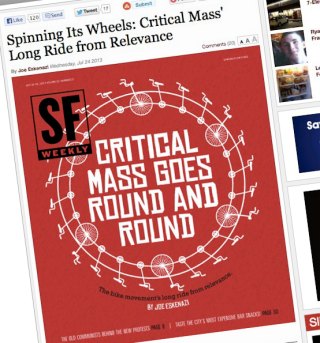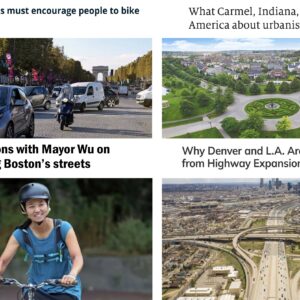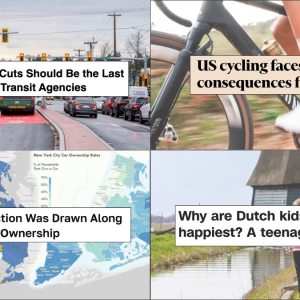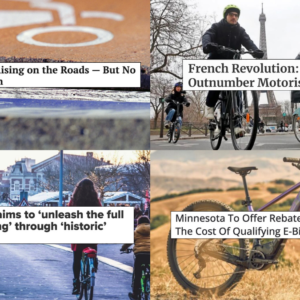
Here’s the bike news that caught our eyes this week…
Cities are safest: “Want to keep your family safe? Then raise your kids in the city.” Rural areas are statistically more dangerous, and we’ll give you one guess as to the type of injury to blame.
History of jay walking: Before auto companies could successfully appropriate rural technology for urban transportation, we had to “socially reconstruct” the city street as a place where only country rubes (“jays”) would cross without looking both ways … and maybe get sued for it.
Vibrating bike seat: Hey, whatever gets more people in the saddle.
Auto enforcers: Two representatives from auto company Citroën paid an unexpected house call to Mikael Colville-Andersen after his blog Copenhagenize ran an video satirizing auto industry advertizing by noting that cars kill. He took it down.
Biker, 15 points: A 26-year-old Redlands man is under arrest for allegedly using his Honda Civic to deliberately sideswipe people on bikes.
Bike lanes, at last: “It took two years of love, perseverance, and collaboration” for Brooklyn’s poorest neighborhood to get the valuable amenities that another group has fought tooth and nail in one of Brooklyn’s richest.
Women’s racing advances: With the statement by the race’s owner that a “women’s Tour de France” is possible, the campaign for women to get equal footing in bike racing is rolling fast.
The decline of Critical Mass? The co-founder of the movement “has observed a five-year ‘golden age’ before they ‘lose their magic’ and become institutionalized rituals,” according to SF Weekly’s cover story.
Speaking of Critical Mass, Portland-based documentary journalist and publisher Joe Biel has finished his 74-minute film on the subject. Biel started working on Aftermass – Bicycling in a post-Critical Mass Portland five years ago and he just sent it out to film festivals around the globe. (Stay tuned for more coverage.)
The secret to bike transportation: home location. Yahoo interviews a finance columnist who recommends saving $12,000 to $15,000 per year by replacing car trips by bike. The trick: figuring out what parts of your town are bike-friendly, and prioritizing that next time you move. (We couldn’t agree more.)
Congestion prediction: Walk Score’s latest home-searching tool estimates auto travel times during rush hour.
Bike industry analysis: You know bicycle manufacturing is coming into its own when financial analysts start tracking it in depth.
Bikes spice up Detroit: Bicycling.com’s Elly Blue reports on a Sunday “Bike & Brunch” ride organized last year by a group of mostly young black Detroiters whose main operating rule is “NO NEGATIVITY WHAT SO EVER.”
Armstrong back on a bike: He joined the Register’s Annual Great Bicycle Ride Across Iowa “for fun” last week and told the media “‘my bad’ for ‘playing along’ with doping.”
Greener states: Carbon emissions from Oregon and Washington didn’t rise from 2007 to 2010 despite population growth, thanks in part to less driving per capita.
Street redesigns needed: British doctors say helmets help minimize brain injury but don’t prevent the more common causes of death on a bike: chest and pelvic injuries. Good street design is essential, they say.
Not so swamped: Streetfilms asks Dutch experts if they feel “swamped by a sea of bicycles.” “The success is a challenge, but not a problem,” says Amsterdamize’s Marc van Woudenberg.
Do sharrows work? Lots of people don’t know what the shared lane markings mean, CBS Los Angeles says.
Cargo bikes in NYC: In your video of the week by Edible Manhattan, the owner of two New York restaurants says “I can’t imagine why every business doesn’t have their own cargo bike.”
If you come across a noteworthy bicycle story, send it in via email, Tweet @bikeportland, or whatever else and we’ll consider adding it to next Monday’s roundup.






Thanks for reading.
BikePortland has served this community with independent community journalism since 2005. We rely on subscriptions from readers like you to survive. Your financial support is vital in keeping this valuable resource alive and well.
Please subscribe today to strengthen and expand our work.
Its not just people who dont understand sharrows… many cities paint them in the wrong place!
Agreed. A city near where I grew up has sharrows, but they are not quite half the size of those in Portland and right next to the curb…where cars park.
“Lots of people don’t know what the shared lane markings mean, CBS Los Angeles says.”
This is especially true in PDX where PBOT intentionally destroyed the sharrow as a meaningful traffic symbol by using it for bike boulevard wayfinding. When it comes to bicycles, PBOT is anti-right to the road.
And if people (including the cops) don’t know what sharrows are, it’s nobody’s fault but the local or state DOT, for not adequately educating the public.
http://www.latimes.com/news/science/sciencenow/la-sci-sn-safer-in-the-city-20130723,0,3803327.story
Speaking of biking close to home, I was wondering how one might exploit googlemaps’ function that lets you plot the same trip by bike or car. I realized recently that often the close to home trips come out quicker by bike than by car (Cora Potter’s calculations notwithstanding).
The suggested car routes are usually longer because the arterials are preferred, and in some cases slower too. Someone clever with the computer could probably spin this into a nifty app or riff on biking’s advantages.
Maybe a link error for “Biker, 15 points” ? Links to a different story.
— Thanks Craig. Fixed that. Here’s the link. – Jonathan
The first link to the LA Times article about rural v. urban safety is also broken (just eliminate the trailing “/” on the url and it’s fixed).
Also fixed! Thanks.
The decline of Critical Mass does not sadden me at all.
Rural areas like Josephine County are more dangerous in part because they have no police service at night anymore. Scary stuff.
Indeed. Providing Emergency services gets more expensive as the population density goes down, combine that with low density means a lower tax base and it gets very difficult to maintain adequate services in any rural area, at least without substantial subsidies from more populous areas.
So not only will the Police take a while to respond (maybe not until the next morning) but if you’re injured or have a heart attack or anything else it may be a 40+ mile drive to the nearest hospital and there’s a good chance that there’s not an ambulance near by with paramedics to help stabilize you. Then if you arrive at the hospital still alive it may be understaffed, because it is difficult to find doctors willing to work in rural areas (not because they don’t like the area, but because it is difficult to maintain enough patients to earn enough money to pay off your student loans in low density areas) so you may not get the care you need as quickly as you need it. It all adds up to a much higher mortality risk even for things that are very treatable if treated quickly.
I grew up in an exurban area near Minneapolis. People were terrified of urban crime, and gave thanks for living where the (perceived) risk of violence was very low. And yet, injuries and deaths from car crashes out on the fringes of the metro area were actually pretty common. Practically everyone knew someone who’d been killed in a crash.
One of my best friends was killed driving down a dangerous rural road around the time I graduated from high school. I don’t remember Mike’s death prompting anyone (at the time) to question living in a place that forced us all to drive so much, often on 2-lane, 55mph roads. I don’t think anyone made the connection that we were living a higher-risk lifestyle out there. Nor did I, until many years after the fact.
Having now lived in 3 different large cities for nearly three decades, though, I’ve had almost no acquaintances who’ve been severely injured or killed as a result of violent crime (or car crashes). Just based on my own anecdotal experience, urban life is FAR safer.
I grew up in and still live for part of the year in a rural area far from any major metropolitan area. For me the LA Times article reinforces my displeasure with how some people cite studies and researchers.
All statistics pertain to history, and many are now entirely irrelevant to current conditions factoring into potential danger. “You may be safer living in the city than the country, study finds”. What value has that title to those who are victims of death modes more common in cities? What use have we for expressing and/or adhering to statistic-based predictions? I wonder if the article’s author at least slightly misrepresented the researchers’ positions. For example, I am not inclined to believe the researchers actually said people living in densely populated urban areas are “less likely to die” by serious injury or even otherwise convey such a trend.
Statistically speaking, the city WAS “safer” (notice no quote in the article involves Myers using that word) than the deep country. What IS “safer” varies according to our constant decision making and much more. And what I’m most displeased about is something I have no idea has or has not happened – that people might assume based upon the article what WILL BE “safer”, possibly exacerbating all the mode of death trends.
Going between the urban and rural settings, I find myself saddened both at the shrinking rural and rapidly expanding urban populations while people continue learning to cope with themselves and each other.
I meant to add, after people assuming what will be safer, those peoples’ subsequent decisions to live in an urban setting.
Sorta’ surprised this was missed over the weekend..
Witnesses: Hit-and-run driver injures girl riding bike in North Portland
Posted: Jul 28, 2013 12:25 AM CDT
Updated: Jul 28, 2013 12:35 AM CDT
By Kai Porter – email
PORTLAND, OR (KPTV) –
A 9-year-old girl was hit by a pickup and dragged on the pavement while riding a bicycle near her home Saturday afternoon, according to several witnesses.
Neighbors told FOX 12 the man driving the truck didn’t wait for police to show up before driving away.
“He’s like, ‘It’s not my fault. I didn’t see her coming. I got to get to work,'” said Sahaune Randle, who heard the crash right outside her house. “So I took my phone out and took a picture of his license plate.”
She gave the picture to police who are now using it to try and locate the driver.
Sahaune said the driver pulled the girl’s bike out from underneath his truck and drove away. She said the little girl was covered in cuts and scrapes but was able to walk to her house right around the block.
“Her arm was really scraped up and she has injuries on her back,” said neighbor Andrew Darrow. “The skin of her hand was kind of hanging. It was pretty bad.”
Darrow said he waited with the girl and her mother until paramedics arrived. “He said the driver pulled up outside the girl’s home before police showed up.
“He drove up to the house and asked if everyone was ok. I said, ‘No. She’s hurt badly.’ And then he drove off.”
Police said hit and run investigators from the traffic division are taking over the case.
As of Saturday night the driver had not been located.
Copyright 2013 KPTV-KPDX Broadcasting Corporation. All rights reserved.
I guess a child in N. Portland being hit is a lower priority news item than Chris King gourmond fests, and the NYT latestest Stumptown trend obsession.
lazyofay,
Your insinuation that we somehow don’t care about that story because we haven’t posted anything about it is completely off base. I have been trying to find out more info and just haven’t posted anything yet. Thanks for your patience and understanding. Also, for future reference, The Monday Roundup isn’t the place you should look for news about local collisions. Those will be posted to the Front Page and/or Page Two depending on severity, newsworthiness, and how much info we can find out.
Thanks.
I waited till Tuesday to even remark, just to see what gives… Child..hit and run.. seems kinda like that would be considered “severely newsworthy”… sorry.
In other threads on Bike Portland I have multiple times witnessed Jonathan defending his choice to post articles about collisions and to make statements about legally systemic and individual bias against vulnerable road users. This is an assumption on my part, but I get the sense you’ve witnessed much of that same behavior of his. Do you seriously assume, even after his response to your first comment, that he would not find the collision you mentioned newsworthy?
*wonders how he had never noticed “Page Two” on the navigation bar*
I’m glad you mentioned Page Two.
How sad that the recommended solution to car crashes is improved medical care.
Hans Vorknecht of the Dutch Bike Council told me (a few years ago while visiting Beaverton) that as you advance forward in diversifying your transportation mix (building for example more bike and pedestrian and transit facilities, etc.), you will trade one set of transportation problems for new ones – but your new problems will be much more manageable than your old ones. “And of course you must push ahead and solve your new problems.”
I anticipate the Dutch will solve their recent, well-publicized problem of bike “swamping”. Its been my own observation that Dutch bike swamping mostly happens in their largest cities and than there only in a few key places, such as at or around train stations.
I see clues of Dutch problem solving in the below Manchester Guardian book review. I note for example, the photograph of the striking bike parking facility recently built in the town of Alphen aan den Rijn (“Alphen on the Rhine”):
http://www.theguardian.com/artanddesign/architecture-design-blog/2013/jul/15/cycle-friendly-city-bike-lanes
As the Dutch deal with their bike swamping problems, many would agree (I for one) that their problems are far more manageable than the transportation and land use issues we face in so many of our American cities and towns.
Washington County Commissioner Dick Schouten
The Alphen aan den Rijn, Bike Apple parking structure for bikes is interesting. I wonder how its design is working out in actual practice, and whether the town feels it’s been a success. Bike “swamping” is definitely ugly. Portland seems to be a ways from having the bike swamping problem, but it would be exciting if the city’s answer to the growing need for bike parking, was a bit more imaginative than bolting more staple racks to the sidewalk and converting street parking spaces to bike corrals.
I didn’t see the finance columnist substantiate his claim of saving so much money per year just by riding a bike. Now I’m all about bike commuting and using bikes for nearby errands, and I’m also the first to scream about subsidized gas, artificially low gas taxes, and the highway trust fund deficit, but I’ve only ever paid at most $50/week for gas (for a very long commute), and unless you ditch your car entirely that still would come out to less than $3K/year. His argument is really that you can save that much by buying a cheap, used car and leaving it parked in your driveway more often than not.
Seems like a high estimate to me, too, but by far the biggest component of car ownership cost is depreciation, which (if AAA is to be believed, which is debatable) happens even if a car is sitting unused.
http://portlandafoot.org/w/Cost_of_driving#AAA_cost_estimates
Insurance, maintenance, and parking are high costs for many, as well.